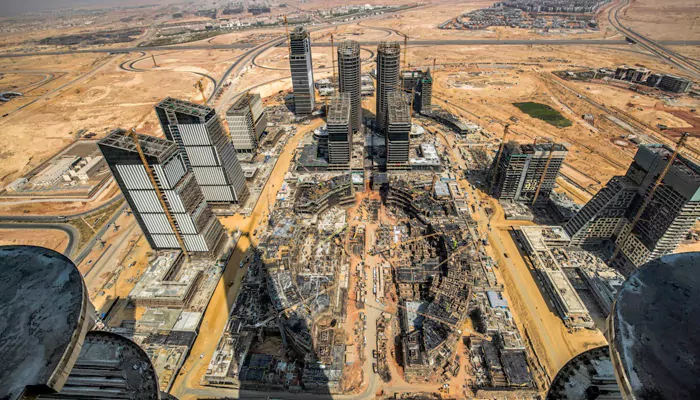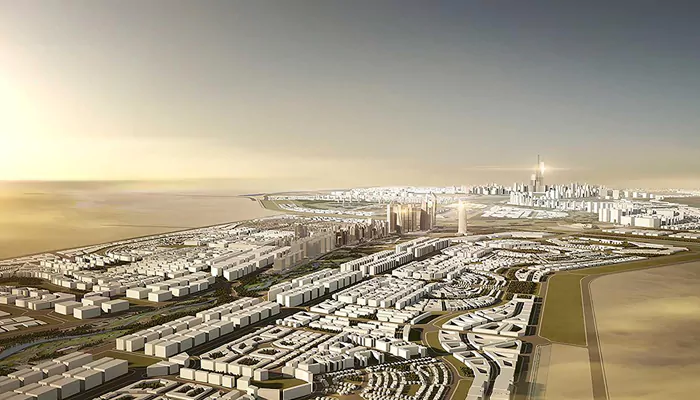Is Egypt's $45bn New Capital City, Captured by NASA, Just a High-End Playground for the Affluent?
- Devyani
- 1 year ago
- 5 minutes read

The New Administrative Capital (NAC) is planned to be a vast metropolis, similar in size to Singapore, with the capacity to accommodate more than 6 million people.
The time-honoured capital of Egypt, Cairo, is famed for its rich history that spans over a thousand years, securing the position of one of the world's greatest cities. However, Egypt is all set to welcome a new capital city. Located 45 kilometers east of Cairo in the desert, NASA has captured images of the now-developing city. The decision of the Egypt government to relocate the capital city comes as a measure to address the growing population, reduce traffic congestion, and curb escalating pollution, as reported by Newsweek.
The images of the new capital captured by the Operational Land Imager (OLI) on Landsat 8 in August 2017 display the initial stages of the city when construction was just underway. The images captured by the OLI-2 on Landsat 9 in August 2024, on the other hand, reveal the city after significant progress and development has been made in the new capital.
Egypt is relocating its capital to a brand new city in the desert outside of Cario. #Landsat captured these images of the new capital in August 2017 and 2024, showing the expansion of the city and several prominent landmarks. https://t.co/jvJhqrEuvA pic.twitter.com/hDgPRSZFpG
— NASA Earth (@NASAEarth) August 31, 2024
Did you know, the construction of the new capital city costs around $45 billion? The construction of the “New Administrative Capital” has attracted a lot of controversy and is part of the ongoing buzz. Questions arise if the new capital of Egypt is merely a swanky city meant for the wealthiest. Come, let’s find out!
A Modernist Vision?

According to reports, for the past seventy years, Egypt has seen the governance by the military that used to rule from buildings constructed during the "semi-colonial, semi-liberal era of the country's last monarchs. In contrast to this, the architecture of the newly built capital city lines more closely with the “authoritarian style of military rule”, and is described as “modernist”. Stretching across 170,000 feddans (270 square miles), the brand new capital city is being developed in phases. The city houses a financial district that will serve as the global headquarters for international businesses and banks. The city is already home to Africa's tallest tower and the largest cathedral in the Middle East. More than 1,500 families have already started residing there, and according to estimates, the number will rise to 10,000 by the end of 2024.
Why are Critics Questioning Egypt's New Capital Amid Economic Struggles and Social Inequality?
Concerns about the project cost have been rising, and according to The Times, people are not really excited or happy about the new capital city given the severe economic crisis and the decline in Egyptian pounds. As per a report by CNN, critics are showing disconcertment about the cost of the new capital city while Egypt undergoes tremendous economic challenges and additional pressures as a result of the war in Gaza.
The inauguration of a “record-breaking mosque” in the new capital city has sparked immense criticism for the expense associated with it. The mosque and its accompanying centers are spread over 19,000 square meters and cost 800 million Egyptian pounds (20.7 million Euros). One critic on the social media platform, Facebook noted that when many Egyptians are suffering and struggling to afford their basic needs, the mosque features “the tallest pulpit” and “the heaviest chandelier”.

According to CNN, many state that the prime motivation behind the building of the new city is to keep the government away from large protests, like the ones that boiled over around Cairo’s Tahrir Square in 2011. Egyptian political analyst Maged Mandour told in a statement to The New York Times that while the poor and middle class of the country are struggling to survive, somehow managing to pay higher taxes, President Abdel Fattah El-Sisi is “borrowing money from abroad to build a massive city for the rich.” The city is being built to accommodate the military and its allies, and it has nothing to do with the broader population of the country. Mandour highlighted that the regime’s goal is to centralize and concentrate power in the hands of the military. The capital serves as the most evident proof of this aim.
According to the Times, many government employees who have relocated from Cairo to the new capital to avoid traffic deadlocks and pollution, are not satisfied with the city. They said that the commute takes up to two hours each day, causing a problem for regular travelers.
The images captured by NASA showcase the stunning landmarks of Egypt’s new capital, including the 10-kilometre-long Green Park where one can find biking and walking trails. There are many government ministry offices situated east of the park. The Ministry of Defense is located in a large facility, popularly known as the Octagon. The images taken also display a large sports complex which is home to Africa’s second-largest stadium. The complex has been designed to garner attention from the Olympic Committee.












